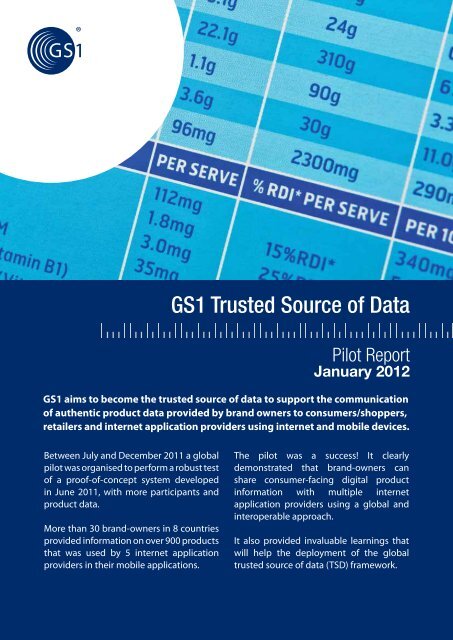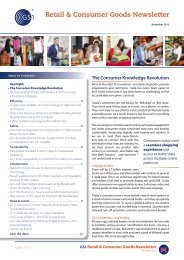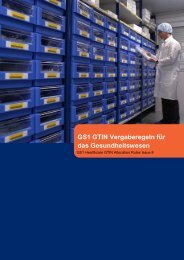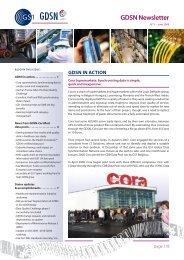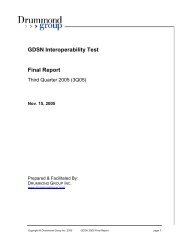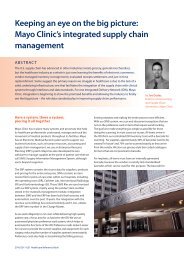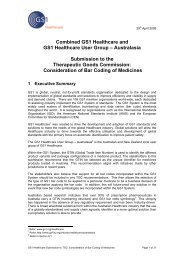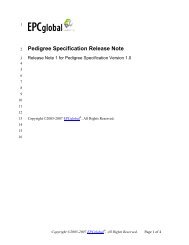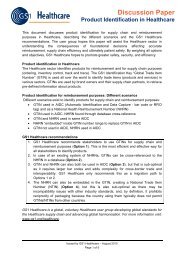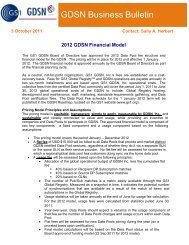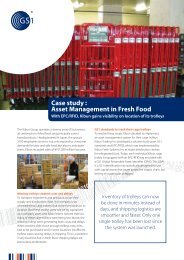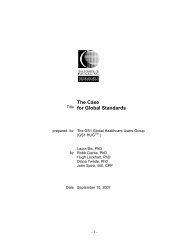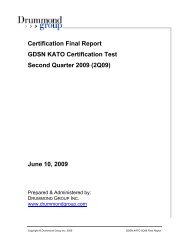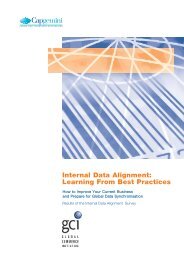Trusted Source of Data Pilot Report - GS1
Trusted Source of Data Pilot Report - GS1
Trusted Source of Data Pilot Report - GS1
You also want an ePaper? Increase the reach of your titles
YUMPU automatically turns print PDFs into web optimized ePapers that Google loves.
<strong>GS1</strong> <strong>Trusted</strong> <strong>Source</strong> <strong>of</strong> <strong>Data</strong><br />
<strong>Pilot</strong> <strong>Report</strong><br />
January 2012<br />
<strong>GS1</strong> aims to become the trusted source <strong>of</strong> data to support the communication<br />
<strong>of</strong> authentic product data provided by brand owners to consumers/shoppers,<br />
retailers and internet application providers using internet and mobile devices.<br />
Between July and December 2011 a global<br />
pilot was organised to perform a robust test<br />
<strong>of</strong> a pro<strong>of</strong>-<strong>of</strong>-concept system developed<br />
in June 2011, with more participants and<br />
product data.<br />
More than 30 brand-owners in 8 countries<br />
provided information on over 900 products<br />
that was used by 5 internet application<br />
providers in their mobile applications.<br />
The pilot was a success! It clearly<br />
demonstrated that brand-owners can<br />
share consumer-facing digital product<br />
information with multiple internet<br />
application providers using a global and<br />
interoperable approach.<br />
It also provided invaluable learnings that<br />
will help the deployment <strong>of</strong> the global<br />
trusted source <strong>of</strong> data (TSD) framework.
<strong>Pilot</strong> Overview<br />
Between July and December 2011 more than 30 brand-owners in 8 countries provided<br />
information on over 900 products that was used by 5 internet application providers in their<br />
mobile applications.<br />
GDSN<br />
Nutritional<br />
Attributes<br />
Consumer<br />
Need<br />
Scope<br />
The pilot is part <strong>of</strong> Phase 1 <strong>of</strong> this project. Phase 1 has been guided by research and<br />
analysis <strong>of</strong> consumer needs, information present on existing product labels and<br />
product attributes already defined in GDSN. As a result Phase 1 is concentrating<br />
on basic descriptive product information and a limited subset <strong>of</strong> nutritional<br />
information shown below. Given the focus on nutritional information, the scope is<br />
also limited to pre-packaged food products.<br />
Nutrition<br />
Label on<br />
Package<br />
B2C Phase 1<br />
Product<br />
Attributes<br />
Basic Product Information:<br />
Product Name / Brand Owner Name /Product Description / Product Image URL / Product URL<br />
Nutritional Product Information:<br />
Vitamins (Vitamin A - Vitamin C) / Calcium / Iron / Proteins / Calories - Energy (Total - Fat) / Carbohydrates (Total - Dietary<br />
Fibre - Sugars) Fat (Total - Saturated- Trans - Polyunsaturated - Monounsaturated) / Cholesterol / Sodium / Serving<br />
Size / Servings Per Container<br />
Participants<br />
The following companies participated in the pilot:<br />
• Brand-owners: Agua Mineral San Benedetto, Almacenes Éxito,<br />
Bonduelle, Capsa, Cadbury, Carrefour, Casino, Coca-Cola, Danone,<br />
Emmi, Eroski, Fromageries des Chaumes, Fromageries Papillon,<br />
Fromageries Perreault, Les Fromagers de Thierarche, Groupe BEL,<br />
Heineken, Hormel Foods, Lactalis, Lesieur, Kellogg’s, Kraft, Marie<br />
Morin, Nestlé, Noel, PepsiCo, Premier Foods, Rausch, R&R Ice<br />
Cream, Smucker’s, Taeq, Team, Tesco and Unilever<br />
• GDSN <strong>Data</strong>pool: 1SYNC<br />
• Certified 3rd Party Content Provider: Brandbank<br />
• <strong>Data</strong> Aggregators: 1SYNC, <strong>GS1</strong> NutriFacts Canada, MO2O,<br />
CABASnet and ProductOnLine.<br />
• ONS: Peer ONS Root name servers, <strong>GS1</strong> Test ONS and EU Root<br />
ONS, managed by <strong>GS1</strong> Global Office and <strong>GS1</strong> France respectively<br />
(until Federated ONS is developed and implemented)<br />
• Gateway Service: <strong>GS1</strong> B2C Alliance “Sandbox”<br />
• Internet Application Providers: checkitmobile, epcSolutions, ipiit,<br />
Mirasense and Proxima Mobile<br />
8%<br />
55%<br />
1% 1%<br />
11%<br />
8%<br />
Product Registration by country<br />
for 910 pilot products<br />
Australia<br />
Canada<br />
Colombia<br />
France<br />
Germany<br />
Spain<br />
UK<br />
US<br />
14%<br />
2%<br />
<strong>Pilot</strong> Framework<br />
The pilot framework was designed to leverage<br />
existing standards based on brand data used<br />
by the Global <strong>Data</strong> Synchronization Network<br />
(GDSN) and other accredited data sources.<br />
A registry function allowed each product’s<br />
Global Trade Item Number (GTIN) to be<br />
matched to the location <strong>of</strong> the aggregated<br />
product information.<br />
Additional<br />
Brand <strong>Data</strong><br />
3rd party<br />
Content<br />
GDSN<br />
<strong>Data</strong>pool 1 <strong>Data</strong>pool 2<br />
<strong>Data</strong><br />
Aggregator 1<br />
2<br />
ONS<br />
3<br />
Gateway Service<br />
<strong>Data</strong><br />
Aggregator 2<br />
4 5<br />
Additional<br />
Brand <strong>Data</strong><br />
3rd party<br />
Content<br />
GDSN<br />
1<br />
6<br />
1<br />
Send GTIN to gateway service<br />
2 Send EPC URI to ONS service<br />
4 Send GTIN and attributes wanted to relevant aggregator<br />
5 Receive attributes back from relevant aggregator<br />
Internet Application<br />
Provider<br />
3 Get back URL <strong>of</strong> relevant aggregator from ONS service 6 Receive attributes back from gateway service
Results<br />
The pilot was a success! It clearly<br />
demonstrated that brand-owners can<br />
share consumer-facing digital product<br />
information with multiple internet<br />
application providers using a global<br />
and interoperable approach.<br />
Testing showed that the average time for data<br />
transfer between internet application providers<br />
and data aggregators was 1.4 seconds. This<br />
means that the time between the bar code<br />
being scanned and the product data being<br />
displayed in the mobile application was on<br />
average between 3 and 5 seconds under normal<br />
operating conditions and so deemed appropriate<br />
for consumer applications.<br />
Example screenshots from two <strong>of</strong> the mobile applications are shown below.<br />
Learning #1: High-quality data is a key to success<br />
<strong>Data</strong> quality is improving. In the pilot, product name was missing in only 2% <strong>of</strong> cases, compared to 75% <strong>of</strong> cases in<br />
a <strong>GS1</strong> UK market study in 2010. Despite this progress, product URL, product image, serving size and servings per<br />
container are attributes that are currently optional within GDSN, hence the large number <strong>of</strong> products missing this<br />
information.<br />
700<br />
600<br />
500<br />
400<br />
300<br />
200<br />
100<br />
0<br />
615 607<br />
420<br />
11 1 20<br />
<strong>Pilot</strong> data quality for key attributes <strong>of</strong> 910 pilot products<br />
Missing Brand Owner Name<br />
Missing Brand Name<br />
Missing Product Name<br />
Missing Product Description<br />
Missing / Invalid Product URL<br />
Missing / Invalid Product Image<br />
GDSN has multiple attributes for product description, thus creating confusion on which attributes should be used for<br />
consumer-facing information and so causing product description to be missing in many cases.<br />
The pilot showed that both a data quality framework for B2C applications and guidance for populating<br />
consumer-facing product data are needed.<br />
Learning #2: Simplify the technical architecture<br />
The Gateway Service served as the interface<br />
between requests from internet application<br />
providers and the response from the ONS registry<br />
about the data aggregator that was storing the<br />
product data.<br />
However, if data aggregators could directly service<br />
internet application provider request then it will<br />
be possible to eliminate the need for a gateway<br />
service managed by <strong>GS1</strong>. In the deployment<br />
phase, the goal will be to work towards the<br />
simplified architecture vision.<br />
GDSN<br />
Additional<br />
Brand <strong>Data</strong><br />
3rd party<br />
Content<br />
Non-Brand<br />
<strong>Data</strong><br />
<strong>Data</strong>pool 1 <strong>Data</strong>pool 2<br />
<strong>Data</strong><br />
Aggregator 1<br />
2 2<br />
ONS<br />
3 3<br />
<strong>GS1</strong> Standards<br />
4<br />
<strong>Data</strong><br />
Aggregator 2<br />
1 5 5 1<br />
Internet Application<br />
Provider 1<br />
Internet Application<br />
Provider 2<br />
GDSN<br />
Additional<br />
Brand <strong>Data</strong><br />
3rd party<br />
Content<br />
Non-Brand<br />
<strong>Data</strong><br />
Scenario 1: <strong>Data</strong> delivered directly from local aggregator<br />
(approximately 80% <strong>of</strong> queries)<br />
1 Send GTIN to aggregator<br />
5 Receive attributes from aggregator<br />
Scenario 2: <strong>Data</strong> not delivered from local aggregator<br />
(approximately 20% <strong>of</strong> queries)<br />
1 Send GTIN to aggregator 3 Retrieve relevant aggregator URL<br />
2 Send EPC URI to ONS 4 Send and receive relevant attributes<br />
5 Receive attributes from aggregator
1<br />
Next steps<br />
The pilot can be deemed a success and the learnings from it are an opportunity to build the<br />
future foundations <strong>of</strong> a <strong>GS1</strong> B2C <strong>Trusted</strong> <strong>Source</strong> <strong>of</strong> <strong>Data</strong> framework.<br />
<strong>GS1</strong> and relevant stakeholders will now focus on the deployment <strong>of</strong> the Global B2C TSD Framework by development <strong>of</strong><br />
global standards and guidelines and a common operational model. Local aggregation has already begun in a number<br />
<strong>of</strong> the participating countries and will continue to operate. It is envisaged that more B2C data, conforming to the global<br />
framework, will be added while the interoperability standards and the operating model are developed and deployed.<br />
Acknowledgments<br />
<strong>GS1</strong> would like to express its thanks to all those who participated in the pilot and in particular to the B2C Project Board, the<br />
<strong>GS1</strong> B2C Experts Group and the staff and resources involved with the pilot at <strong>GS1</strong> Australia, <strong>GS1</strong> Colombia, <strong>GS1</strong> Canada,<br />
<strong>GS1</strong> Germany, <strong>GS1</strong> France, <strong>GS1</strong> Spain, <strong>GS1</strong> US, <strong>GS1</strong> UK, 1Sync, checkitmobile, epcSolutions, ipiit, Ken Traub Consulting,<br />
Mirasense, Proxima Mobile and Verisign.<br />
Find out more<br />
For more information about the pilot and the current status <strong>of</strong> the <strong>GS1</strong> B2C <strong>Trusted</strong><br />
<strong>Source</strong> <strong>of</strong> <strong>Data</strong> project, contact Cameron Green at cameron.green@gs1.org.<br />
Download the full <strong>Pilot</strong> <strong>Report</strong> from : www.gs1.org/b2c<br />
<strong>GS1</strong> <strong>Trusted</strong> <strong>Source</strong> <strong>of</strong> <strong>Data</strong><br />
<strong>Pilot</strong> <strong>Report</strong><br />
January 2012<br />
Brochure JOE cover JAN-DEF.indd 1 26/01/12 13:10<br />
© Copyright 2012 <strong>GS1</strong> AISBL<br />
<strong>GS1</strong> is a registered trademark <strong>of</strong> <strong>GS1</strong> AISBL


